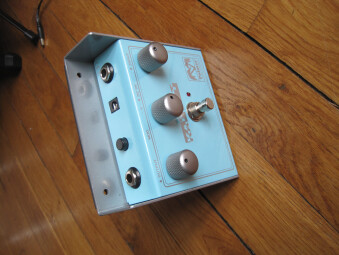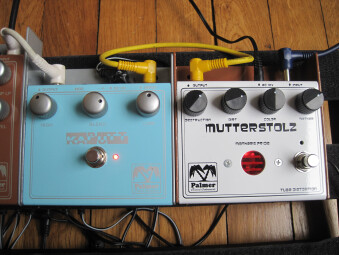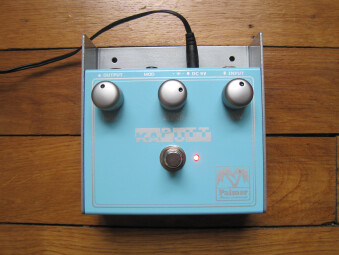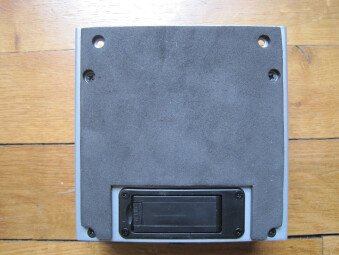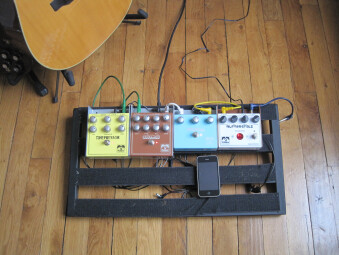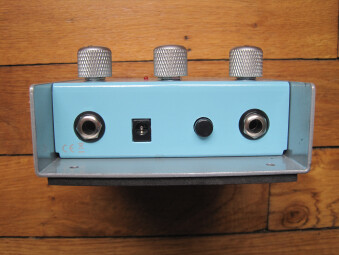With our recent review of the Mutterstolz tube distortion in mind, the Audiofanzine editorial board decided to review some of the other models from Palmer's Root Effects collection. We've already posted our review of Automat, and here we'll focus on Kaputt.
Not Kaputt
Let’s start with the marketing strategy behind the pedal’s name. Even people who don’t know a single word of German will automatically associate it with a completely useless and broken pedal. But rest assured, it isn’t, our pedal is in good health, in very good health, actually. Like the other members in the family, it’s built like a tank.
It has a steel base that is a bit larger than the pedal itself on the sides and top, to protect the cables. You can also screw it down to a pedalboard for more stability, thanks to a couple of holes on its base meant for this purpose. Screwed down or not, it won’t move easily, thanks to the large non-slip pad glued to the bottom, which nevertheless lets us access the 9V battery easily.
The different external components confirm the overall impression of reliability: the footswitch is obviously built to last, and the pots and jacks are made of metal. Next to the switch, a red LED indicates the status of the effect, as well as that of the battery. On the top, we find the Input/Output, a mysterious “MOD” button (whose functionality we’ll show you in the next section) and the input for the 9V power supply.
All this sturdiness does have its downsides: On the one hand is the weight and dimensions (1.7 lbs, 4.7" × 2.4" × 4.7") and on the other the connections. The urge to bring down the wall (the protection base, that is), is inevitable at times. It certainly doesn’t stop you from using the right-angle plugs so frequently used on pedalboards (since they are slightly longer), but it does make it quite a feat to accomplish, especially if the power supply cable is also right angled (which is usually the case).
And, to nitpick a bit, while the logo perfectly describes the effect’s concept in a graphic way (I’m getting there, bear with me!), the choice of a turquoise blue housing (which differs from the blue used for the Compressor of the same Roots family) with a silvery font is unfortunate. It’s very hard to read what the functions of the pots are, so you will have to learn them by heart. There are only three of them, so it shouldn’t be that strenuous, but still. Black doesn’t go too well with it, but at least it’s easier to read on stage. You will surely agree with me when I say that ease of use should prevail over aesthetics.
The German manufacturer makes up for it by including two picks as part of the package, together with the user guide.
So, if the pedal seems relentless, why name it “Kaputt”?
Very Kaputt
The pedal is not broken, quite the contrary: it is the one that messes up, botches, degrades, smears, demolishes, destroys, busts, muffs, shatters…Hmm, in short, it utterly ruins your sound. Broadly speaking, you can dirty up your signal, make it lose definition, like a bitcrusher or a Lo-Fi pedal would, but in an unheard-of manner, thanks to the inclusion of a basic octaver.
To achieve that we have three pots:
- High, on the far left, which controls the rate and quality of higher order harmonics
- Blend, in the middle, which corresponds to a mix or dry/wet control, if you prefer to call it that, and allows you to control the balance between the original and the processed signal (at the center they will be equal, while the processed signal is hard right)
- Low, to the right, is meant to control the rate and quality of lower-order harmonics
Be careful not to get mixed up with harmonics and octaves. The High pot will not add a higher octave nor Low a lower octave to your sound (although the lower octave is standard by default, so to speak).
And, finally, the MOD button on the top of the pedal fully deactivates the Low parameter.
This is the signal chain used for the test: Fender Telecaster Deluxe guitar > Mesa Boogie Triaxis + 2:90 amp > Two Notes Torpedo Live speaker simulator > Apogee Duet soundcard.
For the first example, I chose to show you the raw sound of the octaver, with High and Low set to 0, and blend 2/3 up. The first chord corresponds to the original distorted signal. With the same settings, but turning Blend to the max, we can get very deep lows, as you can hear in the second example. You could even steal the gig of a bassist in a reggae/dub band.

- 1 octaver high0 low0 blenddeuxtiers 00:22
- 2 sub bass high0 low0 blendfull 00:11
Well, actually, you couldn’t, but anyway… For example 3 we have bypassed the Low filter (MOD button pressed) with everything else cranked all the way up. Playing low notes very loudly (it seems as though the pedal reacts to dynamics and note pitch) you can imitate an old synth and steal the gig of a keyboard player in a Kraftwerk tribute band.

Yes, but…no. I’ve always dreamed about composing music for video games, actually. And our pedal can also imitate (even if not perfectly) the typical 8-bit sound. To achieve that, as you can hear in example 4, we kept the same settings as before but started with High set to 1/4, then 1/3, then halfway, 2/3 and, finally, set to the maximum value (every time the music stops corresponds to a new setting). You surely recognized the melody of a very famous video game. But, can you tell from which video game we took the melody in example 5, where we turned the High knob all the way up? (Post your guesses in the comments below. Whoever gets it right will win my deepest admiration and respect).

- 4 highquart tiers midi deuxtiers full blendfull mod on 00:36
- 5 highfull blendfull mod on 00:30
In the sixth example, we will give the effect a more musical use on a bluesy/stoner riff by tweaking all three knobs at the same time: the buzz and grime produced by High (up 2/3) will mix with the murkiness provided by Low (set to max), while Blend is set to 2/3 (we start with the effect bypassed and then activate it). Finally, we have cranked everything all the way up in order to get an Über Kaputt sound (examples 6 and 7).

- 6 riff highdeuxtiers blenddeuxtiers lowfull 00:20
- 7 fullkaputt 00:42
Kaputt or what?
Granted, its use is somewhat limited, and it will hardly find a place in a Madness song (although in an electronic context…). But nobody can say it’s not original. It is an effect, in the full sense of the term, and we can be glad that Palmer doesn’t only settle for conventional pedals, but also tries to innovate with its Root Effects (following the steps of other brands with not-so-big stomp boxes). Given its MSRP of €78 (but available almost anywhere for €60 —roughly $83 at the prevailing exchange rate when this review was posted), it would be a pity to not give it a chance. When Jimi Hendrix decided to use a Fuzz Face, it was far from being widely accepted, but today it is a classic. It’s up to you to bring out the genius in you and put the Kaputt to good use.
Download the audio files (in FLAC format)

